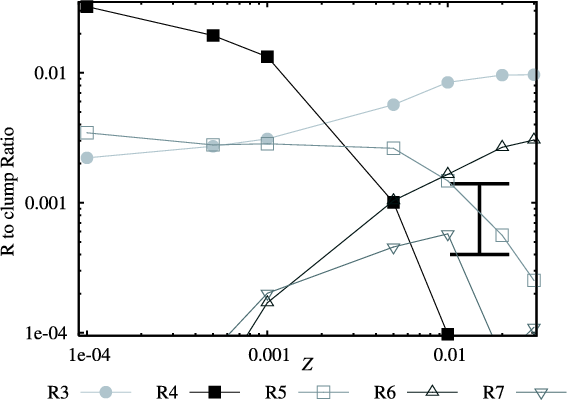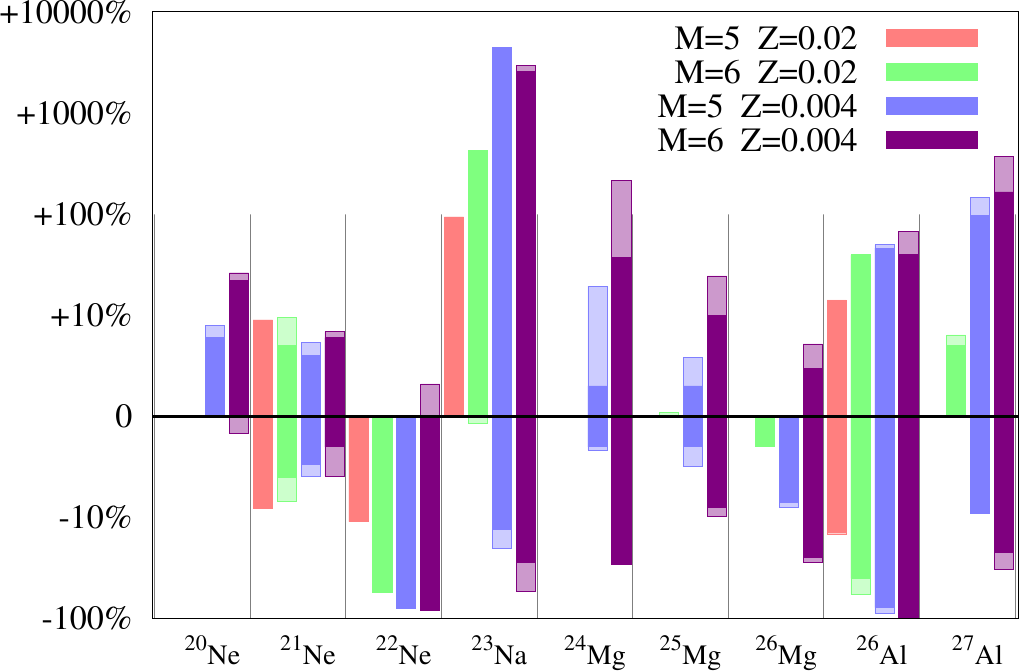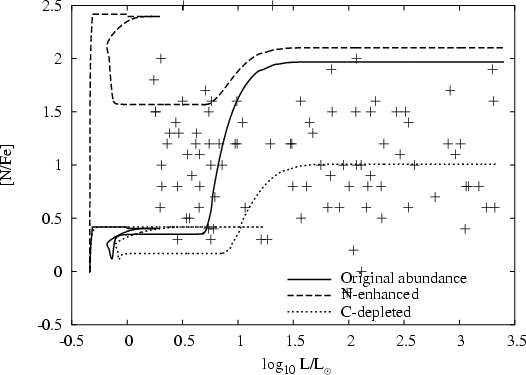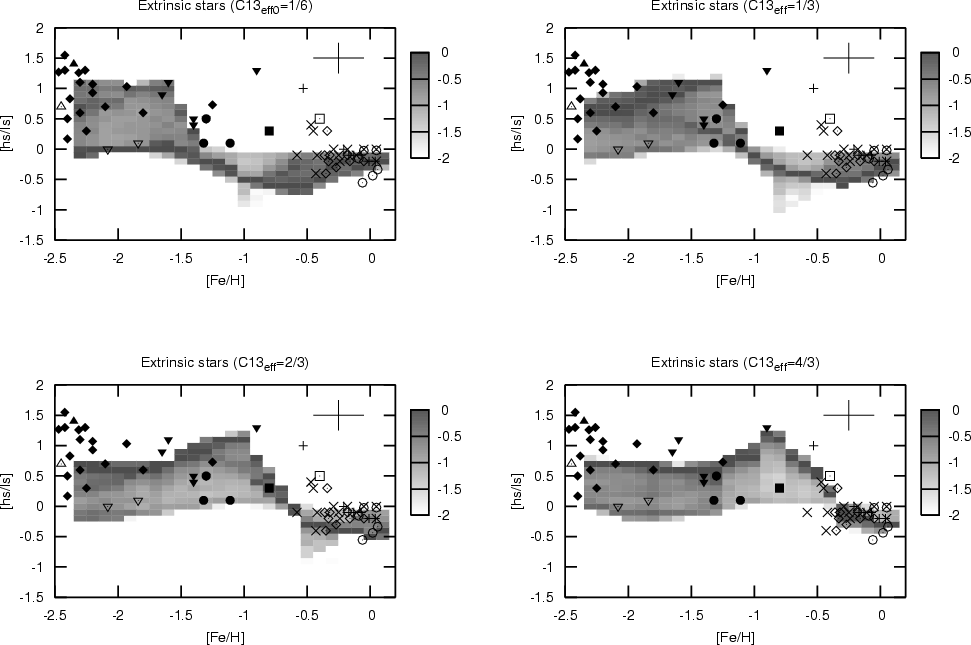| Origin of the early-type R stars: a binary-merger solution to a century-old problem? |
| R.G. Izzard, C.S.Jeffery, J. Lattanzio |
|
The early-R stars are carbon-rich, K-type, thin disk giants which are all single stars. Conventional single-star evolutionary models cannot explain such stars, but mergers in binary systems have been proposed to explain their origin. We have synthesized binary star populations to calculate the number of merged stars with helium cores which could be early-R stars. The most likely formation channel is the merger of a helium white dwarf with a hydrogen-burning red giant branch star.
|
 |
The various potential R-star channels predicted from our binary merger model. |
|
| Astronomy and Astrophysics, Volume 470, Issue 2, August I 2007, pp.661-673 |
| Reaction rate uncertainties and the operation of the NeNa and MgAl chains during HBB in intermediate-mass AGB stars |
| R.G. Izzard, M. Lugaro, A.I. Karakas, C. Iliadis, M. van Raai |
| The uncertainties in chemical yields of Ne, Na, Mg and Al when uncertainties in the nuclear reaction rates are taken into account for hot-bottom burning AGB stars. |  |
|
We test the effect of proton-capture reaction rate uncertainties on the abundances of the Ne, Na, Mg and Al isotopes processed by the NeNa and MgAl chains during hot bottom burning (HBB) in asymptotic giant branch (AGB) stars of intermediate mass between 4 and 6 M⨀ and metallicities between Z=0.0001 and 0.02. The most uncertain yields are those of 26Al and 23Na (variations of two orders of magnitude), 24Mg and 27Al (variations of more than one order of magnitude), 20Ne and 22Ne (variations between factors 2 and 7).
|
| Astronomy and Astrophysics, Volume 466, Issue 2, May I 2007, pp.641-648 |
| Carbon-enhanced metal-poor stars and thermohaline mixing |
| R. J. Stancliffe, E. Glebbeek, R. G. Izzard and O. R. Pols |
| One possible scenario for the formation of carbon-enhanced metal-poor stars is the accretion of carbon-rich material from a binary companion which may no longer visible. We investigate the effect of thermohaline mixing on the surface abundances of a binary system at Z=10-4 with a 2 M⨀ primary star and a 0.74 M⨀ secondary star in an initial orbit of 4000 days. We find that the accreted material mixes fairly rapidly throughout 90% of the star, with important consequences for the surface composition.
|
 |
Plot of the evolution of the [N/Fe] as a function of luminosity when thermohaline mixing is included. |
|
| Astronomy and Astrophysics, Volume 464, Issue 3, March IV 2007, pp.L57-L60 |
| The s-process in stellar population synthesis: a new approach to understanding AGB stars |
| Bonacic Marinovic, A. A.; Izzard, R. G.; Lugaro, M.; Pols, O. R. |
| s-process abundance ratios as a function of metallicity for our single-star models compared to observations. |  |
|
For the first time we have applied stellar population synthesis to the problem of s-process nucleosynthesis in AGB stars, in order to derive constraints on free parameters describing the physics behind the third dredge-up and the properties of the neutron source. We find that galactic disk objects are reproduced by a spread of a factor of two in the effectiveness of the 13C neutron source. Lower metallicity objects can be reproduced only by lowering the average value of the effectiveness of the 13C neutron source needed for the galactic disk objects by at least a factor of 3.
|
| Astronomy and Astrophysics, Volume 469, Issue 3, July III 2007, pp.1013-1025 |
| Binary AGB Nucleosynthesis |
| R.G. Izzard and O.R.Pols |
| The evolution of stars in binary systems is radically different to single-star evolution if and when the stars expand such that their radii is comparable with their separation. This is particularly relevant to Asymptotic Giant Branch (AGB) stars as their radii are many hundreds that of the sun. Their demise may be observed as a planetary nebula. Stellar envelope ejection due to the presence of a companion star truncates evolution up the thermally pulsing AGB and reduces the effect of the third dredge up. As such, binary PNe should not be as enhanced in carbon, nitrogen or s-process elements as their single star equivalents. |
 |
Chemical abundances at the surface of an AGB star at its death for single and binary stars. Stars in close binaries tend to merge, distant binaries hardly interact and those in between can have a very different evolution. |
|
| The proceedings of Asymmetrical Planetary Nebulae IV |
| The Century-Old R-Star Mystery |
| R.G. Izzard, C.S.Jeffery, J. Lattanzio |
| The R stars are carbon-rich K-type giants. For more than a century their origin has remained a mystery. The warmest of them, the early-R stars, have luminosities similar to core helium burning stars yet canonical stellar evolution theory suggests they should not be carbon rich. The early-R stars are chemically peculiar, being enhanced in 12C, 13C and 14N but not in s-process elements, and are all single stars. Binary mergers have been suggested as the evolutionary channel which leads to the early-R stars: we test this scenario with a state-of-the-art binary population synthesis. |
| The proceedings of Unsolved Problems in Stellar Physics |

